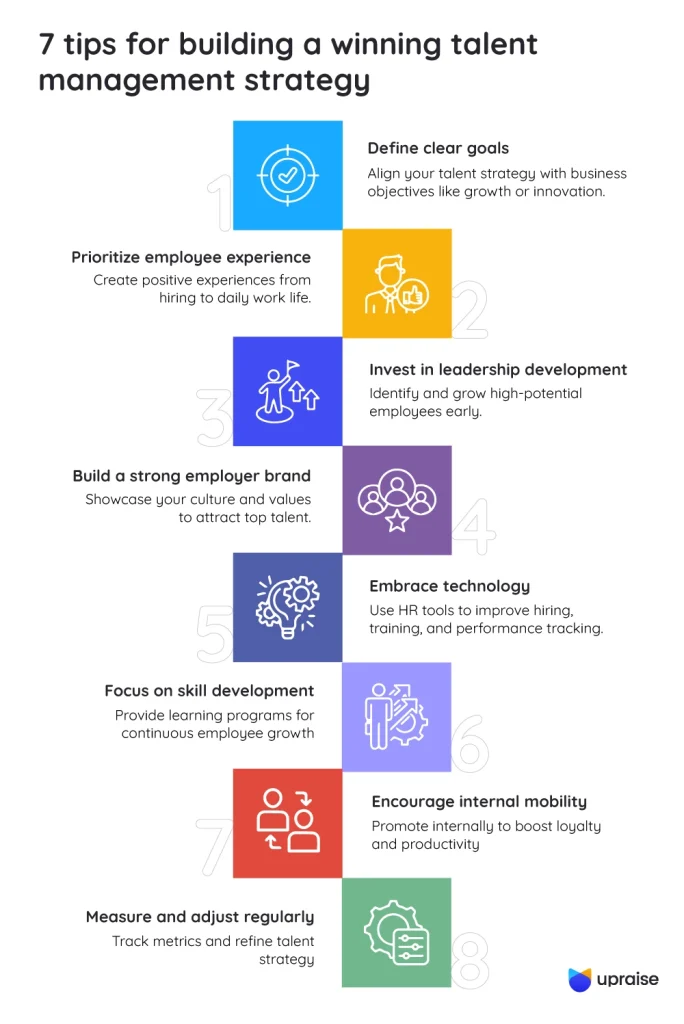Suppose one of your best team members gives you a two weeks’ notice. You scramble to find a replacement, projects get delayed, and morale becomes low. Now picture a different scenario, your team is already equipped with skilled, well-trained professionals ready to step in seamlessly. That’s the power of a future-ready talent management strategy.
A talent management strategy is a long-term plan for attracting, developing, motivating, and retaining employees. It is not just about hiring the right people, rather it is about making sure they feel valued and see their career growing with your business over time.
Having a good understanding and following talent management best practices will help you build a winning team.
What is talent management strategy?
Your employees need continuous feedback and development opportunities for growth and upskilling, if you want them (and your business) to thrive. Think of it like gardening. You don’t just plant seeds and walk away. You water, you fertilize, you nurture.
A McKinsey study found that companies with strong talent management plans are more likely to outperform their competitors in revenue growth. In fact, high-performing organizations generate up to 300% more revenue per employee compared to the median firm in their industry
8 tips for building a winning talent management strategy
Building a strong talent management strategy is key to driving business performance and retaining top talent. In this guide, we’ll walk you through 8 essential tips to help you create a strategy that aligns with your goals and sets your workforce up for success.

1. Define clear goals
Start by asking the important questions like, what do you want your team to achieve? Are you aiming for innovation, efficiency, expansion? Your talent management strategy must be tailored to these business goals. Like, if you’re scaling quickly, you’ll need a talent management plan that focuses on fast recruiting and onboarding.
2. Prioritize employee experience
Treat your employees like customers. Create positive experiences from the first interview to their daily work life. Happy employees are 87% less likely to leave their companies, according to Gallup. Here’s a talent management best practice tip for you: Regularly gather feedback and take real action on it.
3. Invest in leadership development
Leadership development is one of the cornerstones of a strong talent management strategy. High-potential employees often don’t stand out immediately. They may not be the loudest or most visible, but they show promise through initiative, adaptability, and a growth mindset. Identify them early and help them grow. Example: Implement mentorship programs where senior leaders coach high-potential employees.
4. Build a strong employer brand
Top talent wants to work for companies that stand out. Your brand should reflect your values, culture, and mission not just to customers, but to employees too.
You can do this by showcasing real employee stories on your website and social media.
5. Embrace technology
Use the latest HR tech tools for recruiting, training, and performance management. These platforms can help you find better candidates faster by identifying skill gaps before they become a problem.
6. Focus on skill development
The world changes fast. Make sure your employees are improving their skills along with it. Offer regular training programs, online courses, and certifications. According to LinkedIn Learning, 94% of employees say they would stay longer if the company invested in their career development.
7. Encourage internal mobility
Promote from within whenever possible. It reduces recruitment costs and speeds up time-to-productivity while strengthening employee loyalty. Talent management best practice tip: Create clear career paths and communicate them openly to your team.
8. Measure and adjust regularly
No talent management strategy is set in stone. Measure outcomes (like retention rates, employee satisfaction scores, and promotion rates) and adjust your plan as needed. Keeping records of your team can become difficult, but dedicated tools can help. The tool is integrated with Jira, helping simplify the performance management process.
How to align talent management with business goals
Alignment starts with communication. In order for talent to be on the same page as the business goals, our human resource leaders and business heads need to work closely together. Here’s a simple way to think about it:
- Step 1: Identify your business goals. (e.g., open 3 new offices next year)
- Step 2: Identify the people’s needs. (e.g., hire 50 new employees, train 10 new managers)
- Step 3: Build a talent management plan to bridge the gap.
When HR strategies support business strategies, growth becomes a natural result. for example: A tech company aiming for innovation should focus their talent management strategy on attracting creative thinkers and offering continuous learning programs.
Key components of a talent management strategy
A winning talent management plan usually includes these elements:
- Talent acquisition: hiring the right people
- Onboarding: introducing tools, teams, and values to set new hires up for success
- Learning and development: building skills continuously
- Performance management: providing clear goals, feedback, and rewards
- Succession planning: preparing for leadership changes
- Employee engagement: keeping people motivated and loyal
Conclusion
Developing a great talent management strategy is an evolving strategy that needs to be practiced continuously. A forward-thinking, scalable talent strategy is about helping employees in adapting, learning, and evolving. When setting out best practices, ensure plans are aligned with business objectives and your culture is built around people.
A strong talent management strategy goes beyond driving profits and lays the foundation for meaningful, long-term success. It starts with a clear vision and ensures the right people are in the right roles to bring that vision to life.
FAQs
1. How do you create a talent management strategy that supports your business goals?
First things first – you need a clear understanding of what your business is actually aiming for. Once you have that vision in place, you can start shaping your talent management plan around it. Focus on bringing in the right skills, defining critical roles, and building leadership programs that align with your future needs.
2. What strategies come to mind regarding building a robust talent pipeline?
It is impossible to speed up building a solid talent pipeline. It begins with steps to advertise positions before they are available; proactively reaching out before there is a need to fill a role. Establishing internships and apprenticeships also provides advanced access to future skilled individuals.
Don’t forget the power of employer branding either. If people already want to work for you, half the battle is won.
3. How can talent management strategies improve employee retention?
When people feel seen, heard, and invested in, they stick around. A good talent management strategy puts employee experience front and center.
Think professional development, clear career growth paths, regular recognition, all those little things that show employees they’re valued. If you get that right, you’ll notice your turnover rates dropping.
4. What role does leadership development play in talent management?
Leadership development isn’t just a “nice to have” it’s the backbone of any long-term talent management plan. When you actively prepare employees for bigger roles, you create a pipeline of ready-to-go leaders. That means no scrambling when someone leaves, no gaps in leadership, and a lot more stability overall. Plus, it keeps ambitious employees engaged because they see a future with you.




